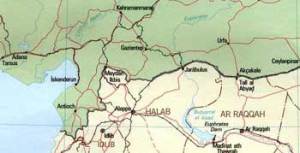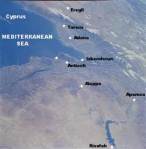Archdiocese
The Archdiocese is expended over 3 governorates in Syria, Aleppo, Idleb and Rakka, besides Alexandretta in Turkey. Though long
distances separate these regions, the parishioners almost everywhere in Syria have settled in the cities. On the contrary, they are still living in the country side in Turkey.
Aleppo is considered to be the second city after the Capital Damascus. It is known by its industry and trading. Its cultural life has been empowered by the presence on the University of Aleppo with its campus that numbers more over than 70 thousand students.
Aleppo is also very singular on the Christian level, since there are 11 different communities: orthodox, catholic, evangelical, Armenian, Syrian, kaldean and Copt. The Council of resident Metropolitans in Aleppo numbers 11 members! Despite this singular Christian plurality in the same geographical area, love and conviviality characterize the relationship between the leaders as well as the parishioners. Mixed marriages form bonds of mutual witness, in the hope that Christian reconciliation and unity will some day be achieved.
Long time ago, Aleppo is considered to be a nucleus for vocations, priesthood and monarchism alike. In fact, the religious and cultural life of the city gave a solid background and provided an appropriate an educational level to support and develop such trends within the different Christian communities, mainly between the catholic ones lately. But we cannot forget the great figures of the orthodox community, last but not least, the Patriarch of the Arabs, the late Metropolitan of Aleppo, Elias IV Mouawad, Patriarch of Antioch and all the East.
The Archdiocese has many reasons to be proud. One of these is being the center where the Aleppian School of Iconography has developed and flourished. While the Byzantine Empire was at end, this region saw the rise of mastership in iconography that follows the Byzantine tradition enriched by the local elements. It produced a lot of wonderful icons that can be seen in Balamand Monastery in Lebanon, or At the Church of the Dormition of our Lady in Aleppo. Now that this school has faded away long ago, attention is given not only to restore its icons, but to give birth again to the school itself.
If the historical patrimony is indeed a big one in Aleppo, unfortunately History came over the Orthodox Church and cut her short, without leaving the slight possibility for recovery. The work of Christian missionaries deprived her of a great majority of her children. On the other hand, the Church itself was in a very critical situation under the Ottoman Empire for many centuries. The fall of that Empire led to the French Mandate. Things went worse, since the French leaders continued the policy of their successive Consuls and did everything to empower the other communities and to weaken the Orthodox. At that level, nothing was left. The Orthodox Church was left as a widow or an orphan.
Therefore, it is noticeable the absence of great organizations in our Archdiocese, educational as well as social. Nevertheless, the situation is not hopeless. There is much room to recover and to make a new start. Better late than never.
The organizations that are working for the moment are of two nature, educational and pastoral:
- Educational Organizations
1. The Sunday School,
2. The Saint Elias Scout,
3. The Theological Seminary,
4. The Cultural Institute of Saint Elias,
5. The Sunday Bulletin,
6. AL-Hekma Bookstore.
- Pastoral Organizations :
1. Nour AL Ihsan,
2. The Sunday School Social Work,
3. Iman & Nour,
4. The Ladies Guilds,
5. The Orders.
 Demographically speaking, Aleppo knew a lot of changes throughout the 20th century. The biggest one was the immigration which origin is Alexandretta and its whereabouts just at the beginnings of World War I. Many settled in Aleppo, others flew to Lebanon and then overseas. Later on, an internal transition took place from the countryside to the cities. Many from Wadi Al Nassara came to Aleppo seeking work and education. Therefore, the composition of our parishes has three different sources: those whose origin is Aleppo itself, and those who immigrated from Antioch and Al-Wadi and settled once for all in Aleppo.
Demographically speaking, Aleppo knew a lot of changes throughout the 20th century. The biggest one was the immigration which origin is Alexandretta and its whereabouts just at the beginnings of World War I. Many settled in Aleppo, others flew to Lebanon and then overseas. Later on, an internal transition took place from the countryside to the cities. Many from Wadi Al Nassara came to Aleppo seeking work and education. Therefore, the composition of our parishes has three different sources: those whose origin is Aleppo itself, and those who immigrated from Antioch and Al-Wadi and settled once for all in Aleppo.

